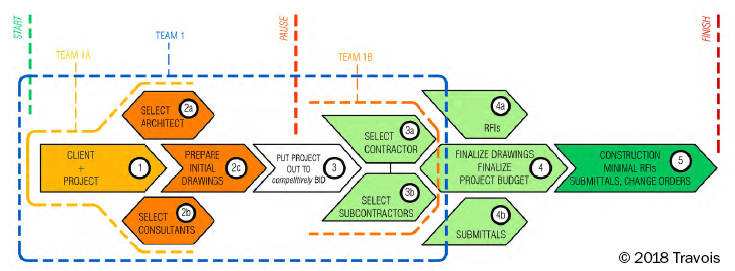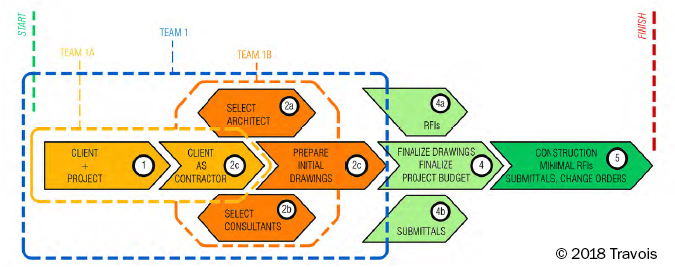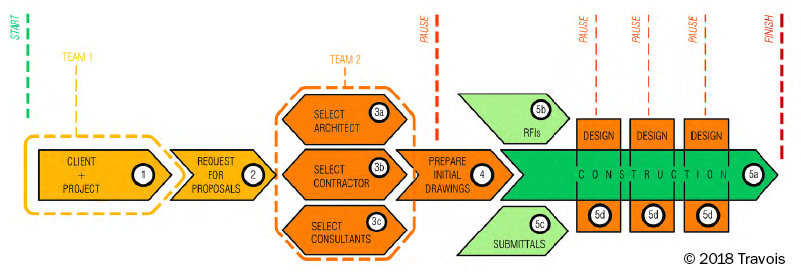When starting a development project, decisions abound. Finding the project delivery method that is the best fit for you and your development team lays a foundation to ensure a smooth process and a successful project.
What is a project delivery method? It is the process by which a construction project is comprehensively designed and constructed – which includes defining the project, organizing the team members, constructors and vendors, structuring contracts, the order of design and construction operations and the execution.
The methods discussed below are applicable for any HUD, NAHASDA, Low Income Housing Tax Credit (LIHTC), sometimes New Markets Tax Credit (NMTC) and other developments with financial stipulations. Even on market-rate developments, some lending institutions will have certain concerns or limitations on project delivery methods.
The four traditional project delivery methods are: Design-Bid-Build, Construction Manager at Risk, Force Account and Design-Build. Here are some of the pros and cons of each method:
1. Design-Bid-Build

Design-Bid-Build is the most traditional and probably most familiar method to most people. It is the best understood, has the longest legal history, and is the most comfortable method for auditors, politicians, public and code officials. Other pros:
- Can produce competitive pricing
- Default method for government-secured developments (often times, special approval is needed with other methods)
- Well-suited to uncomplicate developments by utilizing straightforward objectives
- Less uncertainty
- Least personality driven
Just like it sounds, a project is designed, it’s bid, and it’s built. If only it were that simple. This method is inherently antagonistic; it divides the team, sets team members against each other and can create significant legal issues when unforeseen problems arise. More cons include:
- Encourages cost-cutting and lowest quality for lowest price; can lose quality in periods of high escalation
- Low bids can encourage high change orders
- Can be difficult for inexperienced contractors in constrained environments
- Team 1 is solely liable for design
- Can be dangerous for inexperienced owners
- Potential philosophical disconnect
2. Construction Manager-at-Risk

Construction Manager-at-Risk is gaining more momentum, although HUD approval is generally still recommended for affordable housing developments that use NAHASDA or other HUD funding. The CM-at-Risk method ideally creates a team environment from the start, saves time, incorporates input early on, and is suitable where facility operations must continue during construction. Other pros of this method are:
- It can work well for sites where early construction contractor participation is desirable
- Minimizes Requests For Information (RFIs), change orders and streamlines the submittal process
- Relies on relevant expertise, pricing and availability of materials and construction methods
- Provides more certainty than design-build
- Still allows for competitive pricing
- Pricing and cost model are developed along with the design
- Forces an open bidding process
This method requires the right mesh of personalities, a high level of trust and teamwork, and good, open communication. Project staff turnover can create problems. In addition:
- The contractor must be comfortable with being directly responsible to the owner
- The contractor must bid on unknowns, and the owner has to understand that there will be changes along the way.
- The general contractor is the one taking the risk, so owners and the design team need to work as a team with the General Contractor (GC) to stick to the budget
- Potential philosophical disconnect
3. Force Account

Force Account is all in-house. This method minimizes RFIs and change orders and streamlines the submittal process. This method also keeps profits in-house, provides job opportunities and there is no question that the best interests of the client are kept. Other pros include:
- It can work well for sites where early construction contractor participation is desirable
- Creates a team environment from the start
- Saves time
- Incorporates input early on
- Provides more certainty than design-build, while offering some of the same freedom in design changes
- Suitable where facility must continue to operate during construction
- Pricing and cost model are developed along with design
When developments use the Force Account method, some succeed and several fail. It’s implementation requires a high level of overhead, and the risk rate is high. There is also extra pressure to keep costs down, limit any misperception of costs being too high or funds being spent frivolously. Other perils that can befall projects utilizing this method can include:
- Project staff turnover can create problems
- Must have in-house knowledge and staff during design process and construction
- Force account crew must carry the cost of the project
- Client is responsible for design and construction decisions (There are no checks and balances.)
- Must demonstrate proven ability to be able to manage and carry the project
- Funding options will not always allow force account
- Bonding or Letters of Credit may not be possible to obtain
4. Design-Build

For the majority of our particular developments, we cannot pursue Design-Build. This method requires approval from HUD, partnerships, investors and lending institutions due to its high degree of uncertainty. Project owners, code officials and lending institutions may not approve a project without having a complete picture. Additional cons of this method are:
- It can be difficult to promote competition and requires competent bridging documents
- Can be expensive because it is faster, and decisions may be made without knowing all of the facts
- Needs defined conflict resolution process
- Requires extensive communication
- Less checks and balances in place
Despite the pitfalls, some projects and funding sources will allow Design-Build if it’s approached in the right way. One recent example is the Karuk Tribe Family Services Center. It was Travois Design’s first opportunity to submit and work on a design-build project and was allowed because of the Karuk Tribe’s award of Indian Community Development Block Grant (ICDBG) funds in 2016.
When done so, this method has many pros:
- It can work well for sites where early construction contractor participation is desirable
- Can create a team environment from the start
- Saves times/fast tracks projects on tight timelines
- Incorporates input early on
- Minimizes RFIs, change orders and streamlines the submittal process
- Well-suited for repetitive and complex projects
- Suitable where facility must continue to operate during construction
- Pricing and cost model are developed along with the design
- Work can start while the design is being finalized and solutions are created in real-time instead of on paper
- Allows for flexibility in as-built conditions
If you have additional questions or thoughts on various project delivery methods, or want to discuss what might work best for your team, please leave a comment below. I’d be happy to provide additional information – it’s one of my favorite topics!


